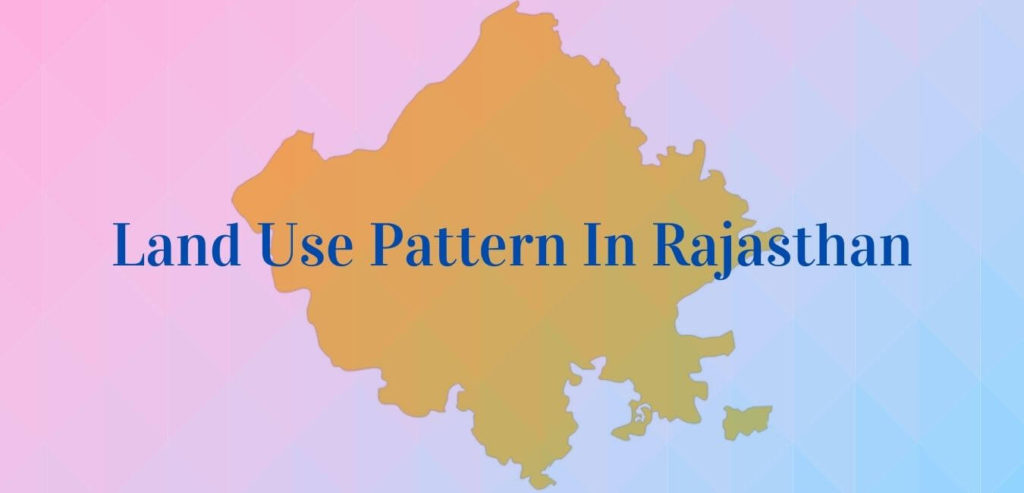Located in north-west part, Rajasthan is the largest state of country, having a geographical area of 3,42,239 hectares which constitutes 10.41% of area of the country. The Land Use Pattern in Rajasthan determines the ecological balance in the region and helps to understand the environmental status as well.
The land use pattern of an area affects vegetation, land quality, local weather and quality of life. It is very important to understand the land use pattern of any area and the dynamics of its shift overtime. This determines the ensuing per unit load on agriculture land, forest land, periphery areas to cities and factors responsible for land degradation.
Land Use Pattern in Rajasthan
Land use pattern in Rajasthan is as follows:
| S.NO | Land Use | Area (in Lakh Hectare) | Percentage |
|---|---|---|---|
| 1 | Net Sown Area | 179.48 | 52.34 |
| 2 | Area under Forests | 27.72 | 8.08 |
| 3 | Non Agricultural Uses | 20.10 | 5.86 |
| 4 | Permanent Pastures & other grazing land | 16.67 | 4.86 |
| 5 | Land under Misc. trees & grooves | 0.30 | 0.09 |
| 6 | Culturable Wasteland | 37.27 | 10.87 |
| 7 | Fallow Lands (other than current fallow) | 20.93 | 6.10 |
| 8 | Current Fallows | 16.75 | 4.89 |
| 9 | Barren & Uncultivable Land | 23.67 | 6.91 |
| Reporting Area for Land Utilization | 342.89 | 100 | |
| Total Reported area of Rajasthan | 342.89 |

Land use Pattern in Rajasthan: Analysis
Net-Sown Area:
- More than half of the total report area is under agriculture operation which proves that Rajasthan is still essentially an agricultural state.
- The high density (above 50%) districts are Alwar, Jaipur, Bharatpur and Tonk in eastern Rajasthan and Churu , Jalore, Jhunjhunu, Sikar, Nagaur and Ganganagar, Hanumangarh in western Rajasthan.
Area under Forests:
- Area under forest in Rajasthan is small, the concentration of forests being more in the districts adjoining Aravallis — like Ajmer, Banswara, Bundi, Chittorgarh, Pali, Sawai Madhopur, Sirohi, Udaipur and Kota.
- Due to low rainfall and aridity forest areas are few and almost negligible in the arid zone districts of Barmer, Bikaner , Churu, Sri Ganganagar, Jaisalmer, Jalor and Jodhpur.
- In rest of the districts the area under forest varies from 1 to 2% and are concentrated in the favourable locations of foothill slopes.
Non Agricultural Uses
- These include settlements, building, roads, other lands appropriated for non-agricultural use — like mountains and shifting dunes, etc.
Permanent Pastures & other grazing land
- The availability of permanent pasture and grazing land determines the status of livestock economy in the regions. It constituted about 5 per cent of the reporting area in Rajasthan.
- In Irrigated North Western Plain, the grazing land is also found negligible.
- The Sub humid Southern Plain is endowed with pastures and grazing lands in one-tenth of the reporting area. Largely, it constituted about 4 to 7 per cent across the zones.
- Hanumangarh and Ganganagar have the least area whereas Barmer, Jodhpur and Bhilwara have the largest area under this category.
Land under misc trees & grooves
- Area under fruit crop fall under this category of land use.
- In Rajasthan, the area under fruit crops is also negligible i.e. less than one per cent.
- Churu and Rajsamand districts have no land under miscellaneous trees, crops and groves. Districts Nagaur, Jalore and Hanumangarh cover the least whereas Dungarpur, Ganganagar and Jhalawar cover the maximum area under the same category.
Culturable Wasteland
- Culturable wastelands are wastelands that can be brought under cultivation by providing irrigation.
- Culturable Wasteland is highest in Ajmer, Alwar and Jaisalmer and minimum at Hanumangarh, Jhunjhunu and Bharatpur.
Fallow Lands:
- A fallow field is land that a farmer plows but does not cultivate for one or more seasons to allow the field to become more fertile again.
- Fallow lands includes two types of fallow lands – Current fallow lands & Other fallow (long-fallow) lands.
- Current year fallow are the lands that have been left fallow for the current year, while other fallow lands include lands that have been left fallow for more than a year.
- In arid regions, except in the districts where irrigation is practised the extent of such fallow land is very high; Barmer, Bikaner, Jaisalmer, Jodhpur dominate this category.
Change in land use pattern in Rajasthan:
- In general there is an increase in total area under cultivation in Rajasthan.
- Permanent pastures and grazing lands and miscellaneous trees and grooves are declining having serious unfavourable implications for the ecology of Rajasthan.
- Although growth in forest area is positive in all the regions of Rajasthan still forest area is only 7.8% of total geographical area, which is well below the minimum norms of 33% of geographical area under forests as set under the National Forest Policy (1952).
- There has been declining growth in barren and other unculturable lands. Land that is being released from barren and unculturable land is shifting towards non-agricultural sector.
Reference:
- Economic Review of Rajasthan 2021-22, published in February 2023.
